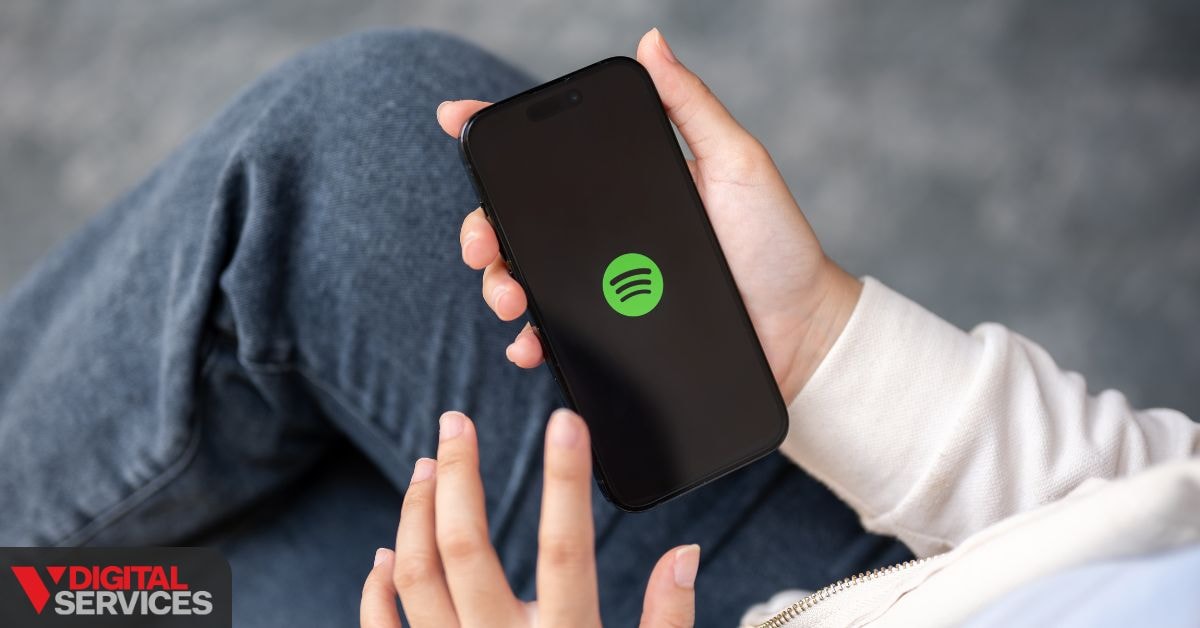It’s no secret that streaming is now the way we watch, listen, and engage with media. Platforms like Netflix, Hulu, Disney+, and Amazon Prime Video have become household staples, while services like Spotify, Roku, and YouTube TV are replacing traditional channels at a record pace. With many U.S. households now using at least one streaming service, it’s clear the shift from cable and radio to digital platforms isn’t just a trend; it’s the future. And as media consumption changes, advertising must evolve alongside it.
Advertising on streaming services – also called OTT (over-the-top) and CTV (connected TV) advertising – is the strategy of placing video, audio, or display ads within content people are already watching or listening to. It’s personalized, targeted, and incredibly effective when done right. Whether you’re a local restaurant looking to reach customers on Hulu, a brand trying to connect with podcast listeners on Spotify, or a national company running video ads across Roku and YouTube TV, streaming ad opportunities offer something for nearly every budget and goal.
At V Digital Services (VDS), we help businesses tap into the power of streaming ads through expert-led, data-driven campaigns. Our team specializes in programmatic advertising, which allows for real-time targeting, optimization, and performance tracking, so your message hits the right audience, on the right screen, at the right time. If you’re wondering how to start, contact us today, and let’s help you build your next breakthrough campaign.
This post will cover what streaming advertising is, the platforms available, the benefits of advertising on OTT and CTV, how much it costs, and best practices to ensure your campaign performs.
What Is Advertising on Streaming Services?

Advertising on streaming services refers to placing video, audio, or interactive ads within content delivered over the internet, such as TV shows, movies, music, or live broadcasts, on platforms like Hulu, Spotify, Roku, YouTube TV, and Peacock. This type of advertising reaches audiences through OTT (over-the-top) and CTV (connected TV) platforms, allowing brands to target users based on location, behavior, demographics, and device usage.
Unlike traditional TV or radio ads, streaming ads are more flexible, data-driven, and often more cost-effective, making them a powerful tool for modern digital marketing strategies.
Additionally, OTT (over-the-top) refers to any content that’s delivered via the internet rather than through traditional cable or satellite TV. For example, Netflix, Hulu, and YouTube. CTV, or “connected TV,” specifically refers to the devices that stream that content – smart TVs, Roku sticks, Apple TVs, and gaming consoles like Xbox and PlayStation. Furthermore, both OTT advertising and CTV open the door to reaching audiences who have cut the cord but are still consuming hours of digital content daily.
This form of advertising offers a fresh contrast to traditional channels like print, radio, or linear TV. You’re not paying to broadcast a message and hope it lands. Instead, you’re targeting a specific viewer, in a specific place, with specific interests, and you’re doing it across devices. Streaming gives you the kind of control and precision that old-school media just can’t compete with.
What Streaming Advertising Services Are Available?
With so many people ditching cable and tuning into content on demand, streaming platforms have become a goldmine for advertisers. From binge-worthy video platforms to music apps and live TV alternatives, the streaming landscape offers a wide range of ad opportunities to fit different goals and budgets. Here are some of these streaming advertising services:
Streaming Video Services
For video marketing ads, there’s a growing list of streaming services offering ad-supported opportunities. Hulu, Peacock, Roku, Tubi, and Pluto TV are just a few of the heavy-hitters. Most of these platforms offer a mix of ad-supported and subscription-based tiers. That means users can watch for free (with ads), or they can pay to skip them, giving advertisers a prime shot at valuable impressions on the free tier.
Even platforms that once swore off ads, like Netflix and Disney+, have entered the ad game with new, lower-priced ad-supported tiers. This is huge because it signals a broader shift toward hybrid monetization and means brands now have access to premium audiences that were once totally ad-free.
Music Streaming Services

Music lovers are also within reach. Platforms like Spotify, Pandora, and Amazon Music offer everything from standard audio ads to sponsored playlists and even interactive audio experiences. These audio spots feel more personal – they reach listeners while they’re driving, working out, or winding down, often with earbuds in and no distractions.
It’s a powerful, intimate way to build brand recognition through voice, music, and tone. Plus, these platforms offer robust targeting by genre, activity, and mood, which means your ad can feel less like an interruption and more like a relevant message.
Live Streaming TV Advertising
If your goal is to reach real-time viewers – for instance, sports, breaking news, or award shows – live streaming TV platforms like Sling TV, YouTube TV, and FuboTV have you covered. Streaming TV ads on these services allow brands to tap into the cultural moment, delivering messages when users are most engaged.
And unlike traditional TV, these platforms still give you access to viewer-level data, cross-device attribution, and targeting tools. It’s the best of both worlds.
What Are the Benefits of Advertising on Streaming Services?
Streaming advertising brings with it a host of benefits that make it a favorite among modern marketers, especially when it comes to ROI.
First, the targeting capabilities are unmatched. You can narrow in on viewers based on demographics (age, gender), location (state, city, zip code), behavior (past viewing habits), and even device. This means you’re speaking to the right person, at the right time, in the right place. This also means no more wasted impressions.
Second, every interaction generates data. From view-through rates to click-throughs to conversions, streaming platforms let you track exactly how your ads are performing and make adjustments in real time. This data-driven approach is what sets streaming apart from more static formats like traditional TV or print.
Streaming also tends to be more budget-friendly. For many businesses, especially small to mid-sized ones, it’s simply more affordable than a network television buy, and often more effective thanks to that laser-sharp targeting.
Plus, you get cross-device reach. Your audience may start a show on their Smart TV, continue it on a tablet, and finish it on their phone – and your ad can follow them across every screen.
Finally, engagement rates on streaming are strong. When viewers are dialed into a show or playlist they love, your brand becomes part of that experience. Completion rates are higher, skip rates are lower, and your message actually gets heard.
How to Advertise on Streaming Services

To advertise on streaming services, you choose a platform (like Hulu, Spotify, or Roku), define your campaign goals, target your ideal audience, create content in the correct format (video, audio, or interactive), and launch your ads using either a self-service portal or a digital marketing partner. From there, you monitor performance and optimize based on real-time data. These steps will ultimately boost your OTT marketing strategy.
Define Clear Campaign Goals
Before you write a single line of copy or film a second of video, know what you’re trying to achieve. You can start by answering some important questions like “Is your goal to build brand awareness, drive website traffic, get app downloads, or boost direct sales?”
Additionally, define these objectives using SMART goals – specific, measurable, achievable, relevant, and time-bound. Then align your ad format accordingly. A short video might work wonders for awareness, while an interactive ad could drive more clicks or downloads. Your goals should guide your creative choices from day one.
Know and Segment Your Target Audience
Streaming platforms provide incredible targeting capabilities; don’t waste them. Use your first-party data to define audience segments by age, location, device, or interests. Then build viewer personas like “young professionals on Hulu” or “commuters on Pandora.”
The more precise your targeting, the more relevant your messaging, and the better your results. Test different segments and see what sticks. You may find surprising patterns in engagement and conversions.
Partner with a Digital Marketing Agency
This step is often overlooked, but it can make or break your campaign. A skilled digital marketing agency knows the platform specs, storytelling strategies, and compliance requirements for each service. They can help you script, produce, test, and launch campaigns across video and audio formats while keeping everything optimized behind the scenes.
More importantly, they know how to read the data and pivot fast. In the streaming world, real-time adjustments can save your budget and boost performance, and a good agency knows exactly how to make those calls. Reach out to us today at VDS and let’s get you results that will speak for themselves.
Create Short, Scroll-Stopping Content
You’ve got a few seconds, so make them count. Start your ad with action, emotion, or intrigue. Keep video ads under 30 seconds whenever possible. Always use subtitles, as many people watch with the sound off. But, for audio ads, clear, warm, relevant tones go a long way.
Your goal is to stop the scroll, earn attention, and deliver your message before the user even thinks about skipping. Remember: the first five seconds are everything.
Prioritize High-Quality Production

This is not the time to cut corners. Streaming audiences are used to beautiful, crisp content. If your ad looks cheap, it’ll stand out, and not in a good way.
Use professional cameras, lighting, and audio equipment. Invest in motion graphics, branding overlays, and a consistent visual identity. A well-produced ad builds trust instantly and helps your brand stand out in a sea of content.
Monitor and Optimize in Real Time
Once your ad is live, don’t just sit back. Watch it closely. Track completion rates, CTRs, and conversions. Pause underperforming creatives, and reallocate budget to the ones getting results. Furthermore, analyze the data weekly and even daily if you can. Streaming platforms give you tools to improve mid-flight. Use them because that’s where the real ROI lives.
Ready to Reach Your Audience Through Streaming Ads?
With more people than ever consuming content through platforms like Hulu, Spotify, Roku, and YouTube TV, advertising on streaming services offers brands a powerful way to stay relevant, visible, and impactful in an increasingly digital world. The ability to target specific audiences, track real-time performance, and engage users across devices is changing the game for marketers and businesses of every size.
If your brand wants to stand out, now is the time to lean in. The most successful streaming ad campaigns start with clear goals, smart audience segmentation, high-quality content, and the agility to test, optimize, and evolve. Whether you’re a small business owner testing your first OTT campaign or a growing brand looking to scale across multiple platforms, the opportunity to connect with your audience, where they’re already watching and listening, is too good to ignore.
At V Digital Services, we specialize in helping businesses break into the streaming space with confidence. Our team uses programmatic advertising strategies to ensure every ad dollar goes further, every impression counts, and every campaign is backed by data. Get in touch with us today or explore how our streaming ad services can help drive results that matter.
FAQs
Can You Advertise on Streaming Services?
Yes, absolutely! Most major streaming platforms offer ad opportunities. Services like Hulu, Spotify, Roku, and YouTube TV have dedicated ad tiers or placements for businesses to reach their audiences. Whether it’s video, audio, or interactive ads, streaming opens up flexible options for brands of all sizes.
Is Advertising on Streaming Services Effective?
Very much so. Streaming ads allow for advanced targeting based on demographics, behaviors, interests, and even location. This means your message reaches the right people, at the right time, on the right device. Plus, completion rates and engagement are often higher compared to traditional TV or radio, especially when the content is tailored and relevant.
Can I Track the Performance of My Streaming Ads?
Yes, and that’s one of the biggest advantages. With streaming ads, you get access to real-time performance metrics like impressions, video completion rates, click-through rates (CTR), conversions, and more. These insights allow you to monitor, tweak, and improve your campaigns with precision.
Are Streaming Ads Skippable?
It depends on the platform and ad format. Some streaming services offer unskippable ads, especially in the first few seconds, while others include skippable options after a brief duration. This makes the opening moments of your ad incredibly important. Strong visuals and messaging early on can boost retention and engagement.
Can I Retarget Viewers Who Saw My Streaming Ad?
Yes, with programmatic advertising and the right tracking tools, you can retarget users who viewed or interacted with your streaming ads. This is a smart way to move potential customers down the funnel, especially when combined with cross-device and cross-platform strategies.
Is It Illegal for Commercials to Be Louder on Streaming Services?
It’s not illegal per se, but there are regulations in place, like the CALM Act, that require consistent volume levels between content and commercials on traditional TV. While streaming platforms generally follow these standards, the enforcement and consistency can vary. A professional production team will ensure your ad meets audio compliance without annoying your audience.
What Do You Call Advertising on Streaming Services?
It’s commonly referred to as OTT (Over-the-Top) or CTV (Connected TV) advertising. OTT covers all content streamed over the internet without a cable provider, while CTV refers to the actual devices used to view the content (like smart TVs or streaming boxes). Together, these terms define a rapidly growing space in digital marketing focused on reaching viewers where traditional ads no longer dominate.
How Much Does It Cost to Advertise on Streaming Services?
The cost to advertise on streaming services varies depending on the platform, ad format, targeting, and campaign size. Most platforms use a CPM (cost per thousand impressions) model, which typically ranges from $10 to $50. For example, Hulu often requires a $500 minimum spend, while Spotify offers lower entry points.



